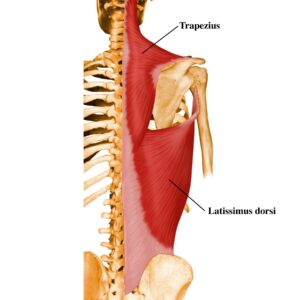How The Rhomboids Really Work
I got to talking with an athletic trainer at a recent seminar, and we were discussing how people really don’t understand how the rhomboids work.
You see, the rhomboids typically get lumped right in with the trapezius complex as scapular retractors – and that’s correct, but not exhaustive enough to illustrate my point. What you want to observe is the line of pull of the rhomboids:

What you’ll see if that this line of pull is quite similar to that of the upper trapezius and levator scapulae muscles, both of which “hike” the scapula up. In reality, the goal with any rowing exercise should be to get the lower trapezius firing as much as possible, as its line of pull depresses the scapula as it retracts – and the muscle is involved upward rotation, which is essential for safe overhead movements.

Note how the line of pull of the trapezius changes as you go superior (top) to inferior (bottom).
As such, you want to make sure that you get your shoulder blades back and down as you do your rowing movements. Here’s an example of what a bad seated cable row, where the scapulae are retracted, but ride up, leading to upper trap, levator scapulae, and rhomboid recruitment.
Much of this comes because of the backward lean, but it’s also possible to have it when in the right torso position.
If you are someone with shoulder issues, you’ll be surprised at what some general massage work on the rhomboids will do to alleviate your discomfort. We know that working on pectoralis minor and levator scapulae will quickly yield results, but rhomboids falls into the same category, as (like these two muscles) they’re involved in downwardly rotating the scapulae.
Click here to purchase the most comprehensive shoulder resource available today: Optimal Shoulder Performance – From Rehabilitation to High Performance.
Sign up Today for our FREE newsletter and receive a deadlift technique video!


